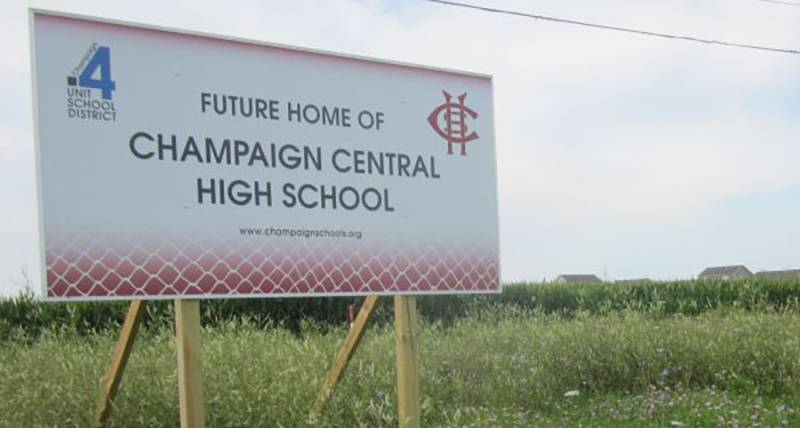“I would never vote no on a referendum,” she said to me, leaning over the table and speaking softly. “I always vote for education.”
But she did.
I sat down for coffee with a woman who is, and has been, closely involved with the movement to prevent the relocation of Champaign Central High School. This is an issue that has existed in the official sense since 2006, but comes coupled with motivations and sentiments that extend much further back into our city’s history and our perpetual consideration of growth and development. Local borders, location, relocation, and the socio-political construct of the neighborhood are things that instill passion and vitriol in a community. They come with the inherent rhetorical power of home: a neighborhood can be a fortress or a curse, but it is always something impactful.
I spoke to this woman with the intention of consolidating my knowledge of the issue, to learn about Keeping Central Central and the way it has operated within our local milieu. I wanted to learn her motivations and to hear from an expert what it meant to keep a high school centralized. Our talk surprised me. I suppose I’m writing an article about why.
I must admit that should have cared more coming into it. I was largely aloof of the issue, and had been for years. I had seen information about the relocation in the campus YMCA and been loosely informed by the opinions of my parents. I could have argued that I had less stake in the matter, and in some ways I guess I might. On paper. I am a childless, unmarried college graduate who currently lives in Urbana. I am cut off entirely from this world of parents and high schools, bus-lanes and after-school sports. But my life is nonetheless deeply connected with Central High School, as much as it is rooted inexorably with Champaign-Urbana. I came to the conclusion that it would be crap to write off the responsibilities of community because of some sort of detached apathy, and thus began my own preliminary research on the issue, where I found that the arguments of the Keep Central Central movement were resonating with me.

The points they make are about space and heating, light and form, parking lots and beauty. They are about creating an environment that is not only accessible and aesthetically pleasing, but one that could foster learning. They are about using what we have to create something wonderful. I am a Champaign Central Alumnus and I remember sweating at my desk in the ninth grade, late August, and only focusing on the damp heat. I remember our shabby gym, cramped hallways and small windows.
We used to call it a prison.
I had expected this interview to be something something bare-boned and factual. I intended to pick her brain on these details and validate a sense of community passion in this way. In my head, it was going to be pretty political. My intention for this piece was to write an article that was both hard hitting and pointed, something sharp that would work conclusively towards an obvious choice about the location of the high school. Cut and dry.
What we focused on more than anything, however, was not necessarily the reasons why a centrally located high school is a good idea, but about the way that ideology and the way we think as a community had shaped the way that these decisions were being made.
More than anything, she told me, this Keep Central Central movement is about saying no. Or more precisely, about feeling okay about the action of saying no. This is a movement of opposition, with the simple goal of shooting down any referendum that would support the tax increase necessary to move Champaign Central High School north of Interstate 74.
What struck me the most about our talk was the way she spoke about a sense of permission: permission for educators and community members alike to still feel like progressive and compassionate members of a community while opposing something that had been billed as essential to development and moving forward. The groundwork of their argument had been laid in factual terms, but the path to ideological resistance was still murky and under-supported.
Moving Central so far North is indicative of a particular mentality that I have noticed more and more frequently in our city. We pursue development in earnest and seem to crave the act of expansion and development as a way to increase both revenues and a sense of community relevance. It seems like we think that bigger is better, and we must chase the Urban part of Micro-Urban because urban growth is a crucial part of progression and development.
We seem to think that growth occurs exclusively outward, as a function of size and shape and external progress. This can be seen laterally, with development pushing ever outward into the countryside and perpetuating a loose urban sprawl that threatens to stretch and striate our neighborhoods. It can be seen happening upwards as well on campus town in the form of massive new apartment buildings that are pulling housing out of low-rent developments and working steadily towards creating a housing bubble. Development is not in and of itself a necessarily good. Progression, if it is simply progression outward, can be problematic.
The Keep Central Central movement helps to challenge these ideals in two ways. First, it has established, pretty conclusively, that there is a great deal of merit in re-using and revitalizing internal space within our community. The arguments for re-use of the original Central building are cogent and appealing, backed by a precedent of similar building projects across the country. Second, it works to fight this majority-favoring ideology that dictates that expansion and remote development is necessarily a boon for both education and for the economic status of Champaign-Urbana.
I like any movement that allows individuals to fight back. In this case we are suddenly allowed to question patterns of thought and development that threaten to whitewash our decision making process. I think it is critical for grassroots movements, composed of compassionate individuals, to continue to crop up around our city and across the country. They help to break apart existing binaries, and help us to keep from stagnating and settling into fixed patterns of thinking and doing. It’s up to the rest of us to fight the apathy that is always lurking about the periphery of our civic lives.
I asked this woman what she planned to do next. She said that they were watching, waiting, ready to raise their voices and keep saying no.
(Top photo by Jim Meadows, Illinois Public Media. Logo by Keep Central Central)








